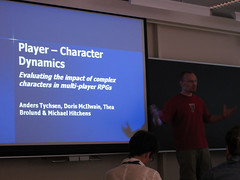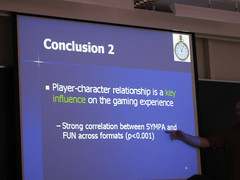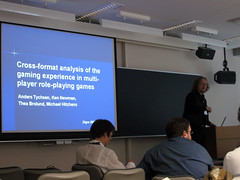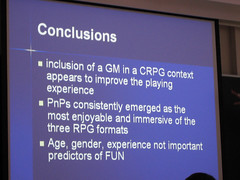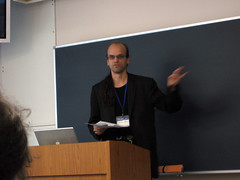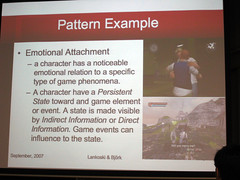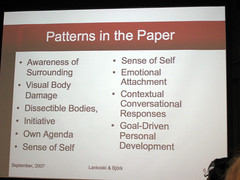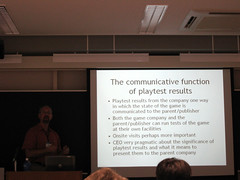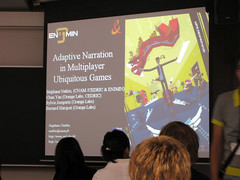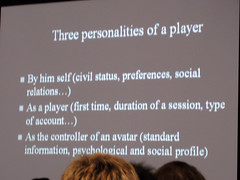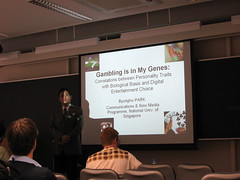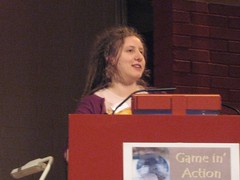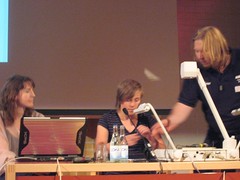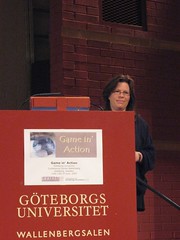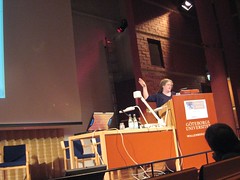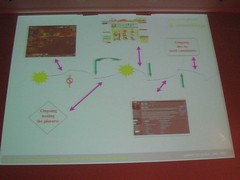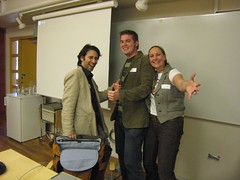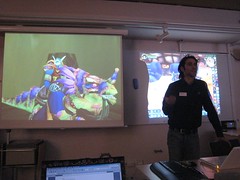The 2007 DiGRA Conference started with a discussion. What I found especially interesting was Bob Appelman’s summaries of what subject areas have been submitted historically to the conference. As a few in the audience pointed out it would have been interesting to see the acceptance rate in the different areas. A bit worrying that there is a trend of fewer and fewer papers on design and implementation. (See photos of slides i put on Flickr)
My take on the discussion in retrospect of the panel is that members need to take more ownership in the organisation. The suggestions to have local geographical chapters and SIGs (special interest groups) seem good. Marinka Copier’s and other’s work in the Netherlands is a good example of how beneficial it can be with local geographical chapters. They meet on a regular basis to discuss and do interesting seminar-stuff. I mostly meet other Scandinavian game researchers at international conferences on other continents. SIGs would be good too. Anders Tychesen, Petri Lankoski and me discussed one regarding player character design (which would have to be a very sub-sub-sig, sine it's so specialised) in the breaks. Emma Westecott suggested having an additional discussion board on Facebook which I think is an excellent idea since it would give an air of casualty to discussions. For some reason, at least for me, the threshold for writing and posting on Facebook is lower than on any other web forum.

Panel:
Tanya Krzywinska (chair)
Bob Appleman
Helen Kennedy
Douglas Thomas
Frans Mäyrä
Esther Maccullum-Stuart.
Jason delarocca
Patrick Crogan
Freeform notes I threw down while listening:
What is DiGRA?
TK: ...work together.... interdisciplinary... important in continues being ID. Diversity. Serve research community. New executive board.
BA: //showing slides.
BG in filmmaking. Games industry adding interactivity. Creating stories. Looked at DiGRA past, taxonomy of papers into different baskets. //photographed.
1st showed papers 2005. …comparison of the 3 years. //design and development has gone down. BA says it bothers him, and I agree.
Delivery modes gone up. Young discipline. A responsibility to bring maturity.
JDL: it’s not the research that should pick the focus; it’s the DiGRA that should. Other organisations that covers what is missing here?
BA: need to put in research from other areas
TK: Inclusively is important. If one narrows too much one could loose enriching diversity.
JDL: Audience?
A1: did that slide show the submitted or published?
BA: Submitted. Does not know how acceptance was
A1: would be interesting to see acceptance rate in comparison to submitted themes.
BA: Agrees.
A2: …
JDL: DiGRA can’t touch so much on tech stuff, so many other venues for that.
A3: there is a split between ppl who work in technical area and those who study critically. I would like to see crossings between that would be better, DiGRA could look at that. Wider grouping. Discussion between those areas.
TK. Good point. Move on. Inclusively. I want to encourage national chapters of DiGRA. One in Japan now and one in Holland. Local chapter that can make conferences, such as post docs. How can we encourage ppl to form new chapters?
FM: I have my own. Future challenge. Incredible what has happened the last years, gone all over the world. Now improve what has been going on. Learning experiences. 27 countries attending this conference. How create more sense of community and contact? Breed cross-fertilization. Important to do it on a national level. Needs identity shift? Main threat currently is to be so thinly threaded that we do not reach a critical mass in any area. Need to have professors in key positions. Junior people now pushing it forward. If everyone spread the work and distribute knowledge reputation will grow within own university structures. Cross fertilisation, new research areas, learning from the existing. That is my take on this.
Julian K: Interesting to talk about organisational structure, and critical mass. But I wonder, could we not be more innovative? We are still thinking in terms of top down organisation in national chapter. Network structures. Message to use to grow DiGRA. Not necessarily grow individual nodes but increase the networkness of DiGRA. Quicker ways of dissemination that the traditional. DiGRA has indeed increased the networkness but is still rooted in the top down view of organisations. We could send out pre conference papers for example, and the DiGRA website is underused. Just an idea.
TK: good point. People still do want to meet in person. Presence in the network, there is work to be done.
Kelly: Hi i'm a developer, new to DiGRA. What kind of activities do you have?
Marinka Copier: We in Holland meet 4 times a year, very interdisciplinary. Bring into practice. Not yet talked about SIGs, but I think those are two ways. I think we need more focus.
JDL: lack of definition what a SIG is. List of tools and resources. In IGDA its totally bottom up, people voicing their needs for SIGs. For chapters though, I do not recommend national chapters. City based is better, so people can meet.
FM: well in Finland its different, basically ten people that met…
JDL: a commute metric. If one can get to a meeting point in one hour for example… //I agree. See Malmö and Copenhagen for example.
TK: Move on now. To Esther.
Esther: Hardcore. It is a short column, aims to come out every month. 1500 words. Make a point. Game studies. Have some kick in it. Pose a challenge. Different ways of looking at games. We want to open this up. We have invited before, but there are so many more with things to say. …that’s Hardcore.
TK: Please submit! So it’s not just from people we know. And if you have suggestions we welcome them.
PC: And do post your comments.
TK: we will end now with Helen. //Helen showing slides.
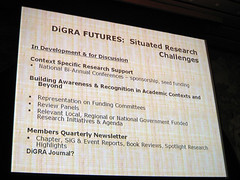
Helen Kennedy: DiGRA future.
Many of us are quite isolated in research. Needs to address this. SIGs.
Context specific challenges. Address by sponsoring smaller conferences. Building awareness and recognition in academia. Quarterly month letter. Want to transform it. Chapter reports and SIGs. DiGRA Journal.
TK. Open floor to questions.
A4: echo Julian. Doing quests together. Go back to where the passion exist, not blog to the ether. Tricky to start. Look to central point. Little more organisation. Past list. Passion. Make things happen. I think the conference is enough.
PC: as soon as you have a board you have a symbolic master. Difficult from board perspective to proclaim that we are now a great network. We don’t get together often enough to form a hierarchy.
DT: suddenly faced with things that have come together, alienated. Disciplinary foundation of knowledge. Lot of books coming out. Canonising certain books. Getting to be a discipline. New comity this year. Struck by a cpl of tings. When submissions came: what are we doing? Categories. Scholarship in game studies. Ask people in review board to pick people to make reviews of papers, have the right people reviewing the papers. Organic development flow. If we have a sense of what DiGRA is it might become exclusive.
TK: facilitating more conversation.
FM: GS can be many things but a certain combination of humanities and sciences. That will continue, it not just game studies. A body of knowledge have organisational issues and shifts of paradigms. Whenever talking about DiGRA its bottom up and network structures. When in need to appear to the outside, then good to appear traditional and hierarchical, look solid. But it is as important to have the coffee room conversations. If we close down DiGRA someone will demand its rebirth, what form would it have.
A5: The conference is the most important thing. People outside the area don’t know that this research is going on. Ppl working in close areas need to know. Need to be promoted.
HK: had a similar experience at a film conference where ppl didn’t know about the research that is going on, but that’s downright sloppy. It takes five minutes on the internet to find out.
Torril Mortensen: work has to happen in smaller groups. AN example from Norway. Of telling people about it and how to find it. What search words people use.
Regional thing important. The joy of talking to someone who understands what one says. That’s why we all are here. What we share. This is what is so important with DiGRA.
BA: You bring up the education of others. Basis in experience of play. True essence. If people have never played games it is difficult to communities. At our universities we invite them to come and see what we do. A huge work to educate the environment around us.
FM: we are working on a Finnish website. Writing basic facts about game studies for a broader audience. I recommend to do it nationally had been really good.
A6: Is DiGRA reaching out into the industry? I represent the serious games institute. Also UK Government. R&D. Collaboration between DiGRA and industry, how much collaboration is there between academics and industry?
TK: It is happening locally. Situated. A key thing that needs to grow.
HK: It’s not a one way street. What partners do you have?
A6: Several universities. Learning, Animation, Interactive Design. Complementary skills. When companies go out and pitch they have an academic ground.
DT: this question comes up on most conferences. Industry saying: help us sell more games, and researchers saying: give us more data. We need a space for this discourse. Our function is not only to make better games.
EMS: many games researchers wearing many hats. Local structures often randomly deciding what kind of departments they are in.
TK: function of DiGRA to facilitate conversation.
JDL: can DiGRA serve its members by creating those bridges? Comes down to what DiGRA is, what is most important; publishing, networking, contact with industry…. Bottom up organic nature. The board already don’t too much. There was a sense of need for a board, and then every one else just stepped back. Should I be doing it or should someone in the board do it? I would also want to know if you are members… half of the room not members. (Hands in air). That needs to chance. //am I a member? I cannot remember. I must ask.
Ren Reynolds: DiGRA a thing of identity. But we do some things…. We had a symposium in Edinbrough with academia and industry, but I didn’t think of asking DiGRA… now i’m setting up a think tank, but should I talk to DiGRA about that. What could DiGRA do for me?
Michael Nietche: But maybe DiGRA shouldn’t facilitate everything. Are the DiGRA and the conference the same thing? Maybe you should rule us more…?
JDL: what is holding people back?
FM: DiGRA is on Facebook…RSS feeds.
HK: in response for Ren: it’s a chicken and an egg thing. Members paying there fees would give us some recourses for helping and sponsoring. Hooking people up, finding expertise.
JDL: is there a Wiki set up?
Petri Lankoski: I can put it up as soon as someone has something to put there…
JDL: a Wiki alone can be used for much.
A7: I used to go to the kay conferences and hci and exactly the same issues are addressed there. Design, theory and practice feeding into each other.
A8: Are any of you in the board students?
One.
A8: how can DiGRA help students?
HK: there are student places on the board.
JDL: help students in what context?
A8 (Anders): Any!
JDL: help them become researchers?
A8: a page for job search?
A9: the path to a discipline. Students coming out of masters and PhD… and focus only on games. A problem with being not such an established discipline. Is it important to establish game research as a discipline?
TK: ppl coming from different areas may not stay. It is a discipline when it suits us. It can be an aspect of something else in some contexts. I want both! Multidisciplinary. Not a monolith.
A9: are you saying there is no need for it?
PC: we will have a post doc symposium on publications and publication venues.
TK: running out of time. Thank you so much



